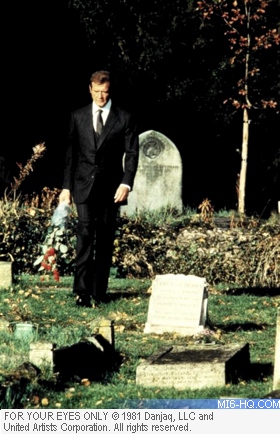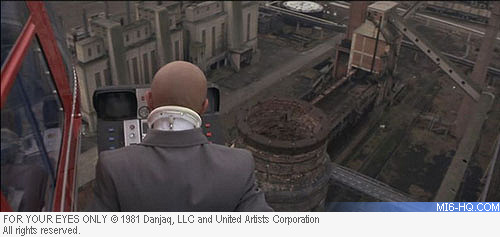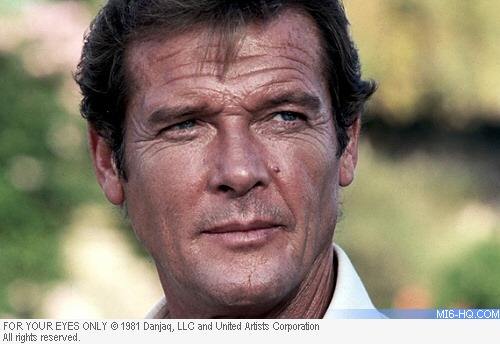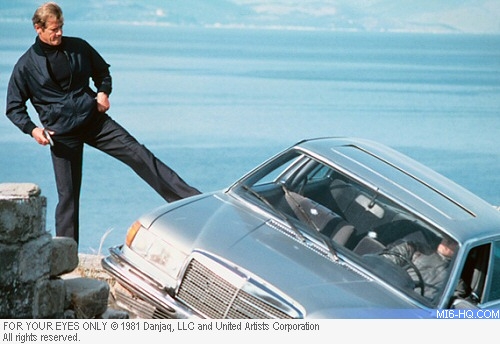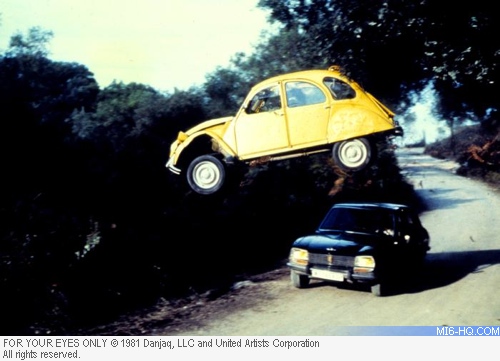For Your Eyes Only And Its Special Effects
10th March 2014
The American Cinematographer interviewed miniature effects specialist Derek Meddings in 1981
 By MI6 Staff
By MI6 Staff
By David Samuelson, from the August 1981 issue of American Cinematographer
Derek Meddings, Special Effects Director on "For Your Eyes Only", won both an Oscar and a British Film Academy Award for his extraordinary special effects work on "Superman". "Eyes" is his fifth James Bond production, his last being "Moonraker", for which he received an Oscar nomination. He has been in the film industry for 29 years and was, in fact, born into it since his mother was Sir Alexander Korda's secretary and continuity girl, his father was a master carpenter at Denham Studios, near London, and his step-father was chief electrician there. His most recent films (apart from the last four Bonds) have included "Shout at the Devil", "Aces High", "Fear is the Key", "The Land That Time Forgot" and "Superman II".
In the following interview for AMERICAN CINEMATOGRAPHER, conducted in London by David Samuelson, he explains in detail how some of the most spectacular mechanical special effects were created for this latest in the series of James Bond sagas:
You're principally known for your miniature work, apart from effects. How did you get into that side of the business? Right: The pre-titles sequence pays homage to Bond's late wife, Tracy. |
|
At this particular time there were very few mattes on pictures, so in between doing matte paintings, we had to find something else to do. Les was also very good at doing miniatures and I would help him. That's how I got involved with miniatures. Although I do all types of effects, I seem to have got myself lumbered, for want of a better word, with just doing miniatures on a picture. On a Bond picture, I supervise all of the effects.
When you first read through the script of "For Your Eyes Only", which sequence presented the biggest challenge to you?
I think it was the helicopter sequence. At the time when the script was written, it was very loosely written because we didn't really have any idea where we were going to do that particular sequence. Then somebody found Becton Gasworks, which is now an unused gasworks covering about 400 acres, and still has all the buildings and all the structure and the gasometers, so it was decided that we would do the helicopter chase around the gasworks. This is when the "baddie" in the picture has lured Bond into the helicopter, then he has electrocuted the pilot and left Bond trapped in the back of the helicopter. Bond has to get out of the back and try to take over the controls, but there's a glass partition stopping him from getting to the pilot. When he gets to the front, eventually - and this is achieved through shooting the door out and getting onto the skid - he has to get the dead pilot out of the seat. Bond pushes the pilot out of the helicopter, but he still can't fly the craft, because it has been wired in such a way that the "heavy" is controlling it by means of a radio control. The idea, of course, is that he's intent on giving Bond a hairy ride, a terrifying ride, before crashing the helicopter into something and killing him.
The "choreography" of the helicopter over the gasworks is quite intricate and exciting to watch.
Yes. The script called for the helicopter to fly under a lot of structures, go into a building (where Bond gets control of the craft), fly around inside and then come out of the building. The problem was that there was no building there that we could actually fly into. On one of the large buildings I fixed up a foreground miniature, so that we could actually lengthen the building with the miniature and make on opening that the helicopter could be made to appear to fly into. In this particular shot, the helicopter was supposed to fly into the building and come out the other side. We found a place where we could make it look like that was happening.
After that, he flies into another building, doesn't he?
Yes. By that time, we were trying to extend the sequence to make it more exciting. This time he flew into one which was quite open; you could see through the building in lots of places. So, again, I did it with a foreground miniature, a large miniature, using a real helicopter which could fly, or appear to fly, into the building. As it flew into the building we created a certain amount of dust supposedly kicked up by the rotors, but this was all done on the foreground miniature. Actually, the helicopter didn't create any dust at all; it just appeared to. Now, the big problem was that we had to get the full-sized helicopter inside the building and it had to look as though it was actually flying in the building. Although the building was very large, it was impossible to get the real helicopter inside it - and even if we could have got it inside, there would have been so many obstacles that it would have been a very dangerous operation.
|
A problem indeed. How did you solve it?
We got a dummy helicopter. I designed a rig which ran on tracks. In a way it was like a large crane arm, but the helicopter sat on one end of this on one single spindle. We could control the helicopter from the other end of the arm and we could make it do all of the maneuvers that a real helicopter would do - like dip its nose with the rotors going round. It could turn around 360 degrees and fly back the other way; it could bank; it could do the lot. So it meant that all we had to do was get Roger Moore into the helicopter. We could position the camera crew anywhere along this arm that we had built and they could get shots of Roger actually seeming to fly the helicopter. Underneath it, again, we created a dust effect, as if it were caused by the rotors kicking up all the dust on the floor of the building. It covered up the one single rod holding the helicopter to the rig. This meant that Roger could sit in it and you could show the whole helicopter and it would look like Roger was flying it inside the building.
Presumably, though, there was also some real helicopter flying to intercut with the dummy helicopter shots. What sort of craft did you use and who was the pilot?
The helicopter was a Jet Ranger and it was flown by Marc Wolff. He is an American who was trained in Vietnam to fly helicopters and he is really superb. There is absolutely nothing he can't do with a helicopter. In this sequence, after Bond finds the secret little box and yanks out the wires, he takes control of the helicopter and flies it out of the building. Now he is looking for the man who had been controlling the craft with his radio control outfit up to that point. He spots him on a roof, crippled and in a wheelchair. It is Ernst Blofeld, who was the villain in several of the previous Bond films. Blofeld can see the helicopter on a little screen. Bond spots him and, in this particular sequence, he flies very low along this flat-top roof. Blofeld looks around and sees the helicopter come over the parapet of the roof. He tries to get away in his motorized wheelchair, but Bond spears the wheelchair with one of the helicopter skids, lifts him up and flies him on a very hectic, terrifying flight around the gasworks, finally taking him up to the top of the tallest smokestack. Blofeld is screaming, "Let me down!" Bond says, "So you want to get off." By this time he is positioned right over the top of the chimney. He just tips the helicopter forward and the wheelchair slides off the skid and plunges right down the chimney.
How did you manage that?
It all sounds very easy, but we had to do it for several cuts. We got a motorized wheelchair and built a special little unit on the back of it. Then we got another wheelchair and fixed a full skid on it. We sat the cameraman on this wheelchair and pushed him as fast as we could, chasing the other wheelchair on top of the roof. What we got was a point-of-view shot looking over the top of the skid as we were chasing the wheelchair. There was one little place on the back of the wheelchair where I had to hit him precisely, because there was a special tube that had to connect. After a couple of goes, I managed to get it in there. Then we cut the camera, put the wheelchair on the helicopter and fixed it on with a quick release. We next took the helicopter back and made him repeat the whole flight across the roof, so that we could cut at a point where the skid went into the back of the wheelchair. We could then cut to a wider shot of the helicopter flying off the roof with the wheelchair stuck to it.
|
What about the man in the wheelchair?
For part of the sequence we had a stuntman in the wheelchair. The wheelchair was very firmly fixed, as the Air Registration Board insisted that we build certain modifications into both the helicopter and the wheelchair, so that there was no possibility of it coming off with a man sitting in it. Then we substituted a very good dummy for the stuntman, and also a specially constructed wheelchair with a quick-release mechanism on it, so that, at this point, Marc could fly it right over the chimney. We gave him a button that would electrically project the wheelchair off the skid, but we had to fire it off with air, because it wouldn't slide off on its own. Even though the helicopter stuck its nose down a bit, the wheelchair still had to be shot off the skid. Marc lined it up and pushed the button and the air device fired the wheelchair off the skid and straight into the chimney. It took some doing, so it was a good thing that Marc had been trained in Vietnam.
How many wheelchairs and dummies did it take to get the shot?
We had three wheelchairs and three dummies - not really for safety's sake, but so that we could get different angles on the scene. We let Marc have three goes at it and he got that chair down into the top of the chimney every time.
Although you direct all of the mechanical effects on the Bond films, your specialty is miniatures. What was the major miniature sequence in this picture?
There wasn't as much miniature work as in most Bond pictures I've worked on because they don't like people to think that there are miniatures used in those films. They prefer to have the audience think that it was all done for real, but on this occasion, we had a sequence that was shot at a harbor on the island of Corfu (it's supposed to be Albania), where all the heavies have their hideout in a particular warehouse. Eventually Bond and his crew attack the warehouse. The villain of the picture had set the warehouse to explode. When Bond and all his attackers get inside, he pushes a plunger and the whole place explodes. We located a spot on Corfu that had a building on a jetty and it was near a fort - quite a historic fort. All we had to do was build a false roof and blow it off to make it look as if the whole building blew up. When the authorities on Corfu realized what we were up to - we had written them a letter telling them what we were going to do and that we wouldn't damage their historic fort, but they didn't believe us - they said we weren't allowed to blow the roof off this building. That presented us with a problem, because now we had a major sequence that had to be shot elsewhere.
|
Where did you finally shoot it?
What we did was build a large miniature on the backlot of Pinewood Studios. We built the whole area in miniature right down to the last detail, including the jetty, the wharf and two boats. One was a lighter and the other was quite a beautiful sailing ship, a three-master. We built the whole lot. The script called for the villain in a Mercedes to drive along the jetty when he pushes the plunger that blows the building up, just as Bond and his helpers come out of the warehouse. We did most of this on Corfu, but we built a larger section of the warehouse out on the backlot at Pinewood so that we could blow the doors off. It looked quite dramatic. However, the climactic moment of the sequence is when the whole of the jetty and the warehouse erupt in balls of flame, and that we did in miniature. It was about 1/12 scale. The jetty must have been about 60 feet long. The actual warehouse itself was about 2 ½ feet high. Parts of it were quite large, being in scale, but it had to be an exact copy of the site on Corfu because we were actually matching what we had already shot there. We'd done wide shots of the boats pulling into the jetty at night, so everything in our miniature shots had to match - where the lights were, how it was lit, the reflections on the water. It was quite a problem, but by then we were quite used to working on that sort of thing.
Do you incorporate perspective into the models that you use for miniature work, so that they are smaller than they really have to be?
Sometimes we have incorporated forced perspective in the models, but on this occasion there was no way you could do that. The warehouse stood on a jetty and behind it was this large fort, so it wasn't possible to build forced perspective into it.
Obviously you have to work in close cooperation with the cameraman on a sequence like this. Who photographed it and what sort of liaison did you have together?
Paul Wilson does most of my miniature photography and that's because on a large picture like this the main unit cameraman can't get involved in it, although we all discuss it and we work out how his lighting has got to be matched when we come to a shot. We've all worked together before so we do have quite a good experience with these things. Alan Hume and I have worked on a lot of pictures involving miniatures, but when he is doing the main unit, when we've discussed how we are going to do it, then I've come up with an idea on how we're actually going to shoot it. Then it's really down to myself and to my camera crew to achieve that shot. But first of all we wait until Alan has done the main unit shot. Whatever way he lights that, we have now got to match ours. This is where Paul Wilson comes into his own because to me he has got to be one of the best cameramen for lighting miniatures. That is, of course, because he has had a lot of experience working on pictures where we were involved in doing miniature photography. If you think of something like this particular jetty that we shot in Corfu, it was bad enough trying to light the full-size place because of the amount of light that was needed and also to be able to show where the action was going to take place. It had to be lit in certain areas without looking as if it was being lit. Then when we came to the miniature, we had to light it so that we could cut from the full-size shot to the miniature without anybody spotting any difference. That's when Paul really comes into his own as a lighting cameraman.
What sort of filtering and lighting controls does he use that makes it possible to do all this?
We always have to put in fog filters when photographing miniatures. If you shoot it straight you end up with something that is too plain and from the very early days when I used to do miniatures for television series like "Thunderbirds" we always used to filter every miniature shot we ever did. If you are looking outside into the distance, even on a clear day, there's a certain perspective in color. As it gets away from you, a bright red doesn't look a bright red, and also there is this very thin layer of haze that gives you the distance, gives you perspective. On model shots I decide with Paul on what amount of filtering we need to do. When it comes to the actual lighting of the set, I just let Paul go ahead and light it. If I'm doing a shot that involves an effect that I want to create with lighting, then again, I discuss it with Paul and say, "It must be lit from this particular angle or from this particular distance." We don't have any problems with lighting. He just uses his knowledge.
Do you run at normal speed?
No, on miniatures with action you've got to shoot at very high speed. We shoot at 120 frames per second, which means that when I lay the charges, if I don't wrap them too tightly I will get quite a large explosion, but also a visually convincing explosion. You will actually see bits going into the sky. You'll see the buildings start to disintegrate as the charge blows the walls out. If you shot at normal speed, it would happen so quickly that you really wouldn't see anything happen at all. That's why, over the years, being able to shoot at high speed has made shooting miniatures a much more convincing business. We used it on the sinking of the fishing boat. We used the Photosonics camera. This was the first occasion I'd had to use that camera and I felt that to be able to go at 300 FPS on the fishing boat sinking really did help the shot to be convincing. We didn't use it when we blew up the jetty because we only had two S35 cameras and if we had put the Photosonics in and had shot at a higher speed, we'd never have got a match speedwise. So we didn't use it on that. On the sinking of the trawler, it was very effective.
|
Bond pictures are always famous for their car chases. Is there a car chase in "For Your Eyes Only"?
Yes, there is. It involves a little Citroen Deux Cheveaux, one of those bouncy French cars being chased by the big black cars that the baddies have. We were involved in quite a few shots, but really the whole car sequence was put together by Remy Julienne, the French driving stunt arranger.
To what extent was your crew actually involved in that chase sequence?
Really, the special effects became a backup for the stunt work done by his crew of boys. If he wanted something that involved our kind of specialty, we would assist him. For example, when the car leaves the road, crashes down the embankment (turning over on the way down) and finishes upside-down on its roof in the center of the road, we made a special revolving plate, so that the care could be struck by another car and be left spinning on this mountain road. There was also a time, prior to that, when the car goes over the edge and slides down the embankment on its roof. Again, we assisted with that particular shot. When the script called for the tires to be shot out, we had to rig the tires to be shot and then Remy and his boys would do the actual turning over of the car.
Was there any driving sequence in which your team was more heavily involved?
The one sequence where we go more heavily involved was when the baddie gets shot in the shoulder, through the windscreen, and loses control of the car. He skids and crashes into a wall on the edge of a sheer cliff dropping into the sea - a drop of about 100 feet. Although Remy was driving the car, we had to put special restrainers on the car to stop it from going over the drop, and we had to build a dummy wall. We shot this in two different places -- one we shot in a quarry and the final shot when the car actually goes over the edge, we shot on a cliff at the seacoast.
How did you set up the rig for the car to actually topple off the cliff?
We had to build a special rig for the car to sit on, with a unit that would release the car at the push of a button. The car was mounted on rollers and we could actually adjust the rollers to get the car to the edge of the cliff. There is a scene in that sequence that shows a wounded villain sitting in the car. Bond comes up to the side of the car and there is a dialogue between him and the villain. The car slips a little and you can see right past the villain, through the window, what a drop he's about to go over. Then finally Bond kicks the car, which is the straw that breaks the camel's back, and the car slides over the cliff and hits bottom, but doesn't explode. All cars that fall over cliffs in films always explode on impact, but we thought it would be a nice change if this one didn't. The car ends up partly in the sea and party on the rocks at the bottom. There's a shot in which, quite by accident, the body came out of the window of the car as it hit the rocks. I thought it was a bit horrific, but I believe that it's been cut out of the final film.
Special effects are becoming more and more important in blockbuster movies. Do you have any feelings about where special effects are going and whether you are ahead of the scriptwriters or the scriptwriters are ahead of you at this point?
I feel that special effects have always been important in pictures involving disasters. Over the years the Americans and the British have become very good at creating miniature effects, so that they can create a disaster at one-third the price it would cost them if they tried to do it for real. Also, everyone knows that you can't take a camera crew into space, so if you're doing a picture involving space, it has to be done with miniatures. People like George Lucas and Gary Kurtz, who did STAR WARS, felt this way and they came up with some fantastic ways of doing things - which I feel, add up to one of the biggest steps forward in special effects miniature photography in years. Having seen that type of picture, a lot of producers think, "If they can do that, we can do that." For people like myself it means that we've got to be able to create the effects that they write into scripts. We've got to be able to produce it on film. I the future we must, at some time, go into taped and computer effects. I've heard that in America, as well as in Britain, they are getting involved in computerized imagery, which leaves me a little baffled at the moment. I don' t know whether I'm going to continue to work creatively or just sit at a machine and push buttons. I hope we don't get around to just pushing buttons - having to work out mathematical problems before our picture arrives on the screen. If it comes to that, I won't be doing it.
|





